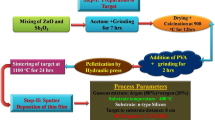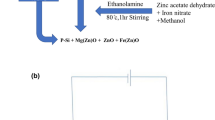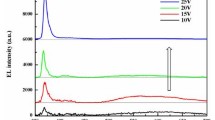Abstract
Based on the easily controllable radio frequency magnetron sputtering, n-ZnO and i-MgO thin films were fabricated on p+-GaN substrate to construct heterojunctional light-emitting diodes for ultraviolet emission from the near band edge exciton recombination of ZnO. Effects of the insulator MgO layer on the electroluminescent performance of the n-ZnO/i-MgO/p+-GaN light-emitting diodes have been investigated. It was found that the light-emitting diode presented stronger near band-edge emission with blue shift emission peak under the lower working current when i-MgO layer was inserted. The fabrication process, characteristics and the mechanism were discussed in detail.
Similar content being viewed by others
Avoid common mistakes on your manuscript.
1 Introduction
Ultraviolet (UV) light-emitting diodes (LEDs) are of great interest for their potential application in long-lifetime solid-state lighting, full-color displays, air and water purification and biomedical instrumentation systems [1, 2]. In virtue of the large exciton binding energy (60 meV) and direct wide bandgap (3.37 eV) at room temperature, ZnO has been regarded as one of the competent promising candidates for UV LEDs [3–12]. Although homogenous ZnO p–n junctions have been reported, the reliable and reproducible production of p-type ZnO films are still in challenge due to its heavy self-compensation [13, 14].As a strategetic alternative, n-type ZnO and p-type GaN, which has similar properties and excellent lattice matching (1.8 %) with ZnO, have been combined to design and fabricate the heterojunctional LEDs even lasing diodes [6–12, 15–18]. Among those previous reports, nanorods (NRs) prepared by various methods, such as hydrothermal approach, chemical vapor deposition (CVD), pulsed laser deposition (PLD), metal organic chemical vapor deposition (MOVCD), molecular beam epitaxy (MBE), have been utilized to fabricate ZnO-NRs/GaN LEDs and obtained blue violet emission due to the confinement effect of NRs and low defect density of interface [9–12, 15–18]. Nevertheless, the manipulation of the nanorods and the fabrication process of the hybrid devices are relatively complicated and can be easily controlled. On the other hand, the corresponding thin film LEDs are much more favorable to be fabricated, however, the electroluminescence (EL) from the ZnO film/p-GaN is usually weak due to both the unfavorable ZnO/GaN band offsets and more nonradiative centers at the interface [19]. Recently, wider bandgap materials such as MgO and ZnMgO have been introduced into ZnO film/GaN LEDs to facilitate carrier confinement and thus improve the EL performance [20–22]. Many reports about ZnO-based LED have been made, n-ZnO film fabricated by the PLD, MOCVD, have been utilized to prepare n-ZnO film/p-GaN LED and obtain blue violet emission [6, 7]. Chongxin Shan’s group has adopted the MBE way to fabricate n-ZnO film/i-MgO/p-GaN heterojunction laser diode [23]. Guojia Fang’s group has reported the n-ZnO film/i-MgO/n-GaN heterojunction LED by the magnetron sputtering with the emission peak 368 nm [20]. Here, the n-ZnO film/i-MgO/p+-GaN LEDs was fabricated by radio frequency (RF) magnetron sputtering.
In this study, RF-magnetron sputtering was utilized to fabricate ZnO and MgO films on p-GaN substrates to form n-ZnO/i-MgO/p+-GaN LEDs. As a commercial film technique, this procedure is relatively simple, low cost and easily to be controlled. The i-MgO film plays an important role in ameliorating the EL performance of the device. The characteristics of the LEDs and corresponding electron transport mechanism were investigated systematically.
2 Experiments
Commercially available p+-type GaN wafers with sapphire substrate were used, which have the resistivity of 1.2 × 10−2 Ωcm. The n-type ZnO with a thickness of ~100 nm was deposited on the p+-type GaN layer by the RF-magnetron sputtering of a 99.99 % pure ZnO target at 2.0 Pa working pressure of oxygen and argon mixture with the flow rate ratio of 1:10. The sputtering power was 100 W. Then the same dimensional ohmic contact electrodes Ni/Au and Ti/Au were deposited on the p-type GaN and n-type ZnO layers by electron beam evaporation, respectively. Two heterostructure LEDs were fabricated: n-ZnO/p+-GaN and n-ZnO/i-MgO/p+-GaN. The MgO thin film was also prepared by RF-magnetron sputtering using a MgO target. The crystallographic structures were analyzed by X-ray diffraction (XRD) using Bruker D8 Advance X-ray Diffractrometer.
The photoluminescence (PL) was performed by the spectrometer (Princeton instruments optical-multichannel analysizer) using a nanosecond pulsed laser of 355 nm as the excitation source. The EL is also detected using a Hitachi F-4600 spectrometer. The absorption spectra of ZnO film was measured by UV-3600 Shimadzu UV–VIS–NIR spectrophotometer. The Electrical characterizations (I–V curves) of devices-as fabricated were performed using a Keithley-4200 Semiconductor Parameter Analyzer. All measurements were carried out at room temperature. The device was run at various forward biases as GaN was applied to positive voltage.
3 Results and discussion
The XRD pattern of the ZnO films deposited on GaN substrate is depicted in Fig. 1. In the spectra, only diffraction from (0002) and (0004) atomic planes of ZnO film (Wurtzite-structure) with lattice constants a = 3.2508 Å and c = 5.2069 Å is observed at 34.63° and 72.76°, respectively. The strongest and narrow (002) peak suggests the high crystalline quality and preferred orientation along the [001] direction.
Figure 2 presents PL spectra of the ZnO and GaN layers. As can be seen, the spectrum of ZnO film displays a NBE emission at about 383 nm. The Mg-doped GaN film reveals a strong ultraviolet emission peaked at 376 nm corresponding to the band-to-band recombination of GaN, and a broad blue emission band centered at 434 nm corresponding to transition from the conduction band or unidentified shallow donors to deep Mg acceptors [24].
The EL spectra of the diodes without and with i-MgO layer were shown in Fig. 3a and b. The spectra of n-ZnO/p+-GaN and n-ZnO/i-MgO/p+-GaN exhibit UV peaks centered at 392 and 385 nm, respectively. Comparing the PL spectra of ZnO and GaN, the UV emission of two diodes was regarded as mainly coming from ZnO NBE emission. When the devices was running at forward bias of 20 V, bright emitting light image could be seen clearly through naked eyes, as shown by the insets in Fig. 3b and c. It can be clearly seen that the light of the device with i-MgO layer at 1.48 mA is brighter than that of the device without i-MgO layer at work current 1.68 mA. For both samples, the UV emission is enhanced with increasing forward bias. Figure 3c shows the emission intensity of the two diodes as a function of the applied forward bias. The emission intensity of the diode with the i-MgO layer enhances faster and stronger than that of without one. Figure 3d plots the emission intensity of the diodes as a function of injection current. Under the same injection current, the emission intensity of the diode with i-MgO layer is enhanced, implying the device’s emission efficiency has been improved.
The EL spectra of the heterojunction LED under different continuous current injection, the insets show the corresponding EL images, a n-ZnO/p+-GaN, b n-ZnO/i-MgO/p+-GaN, c The emission intensity of two diodes as a function of the applied forward bias, d The emission intensity of two diodes as a function of injection current
The current–voltage (I–V) characteristics of diodes with and without i-MgO layer are presented in Fig. 4. The clear rectification behaviors are demonstrated for the two devices. It is estimated from Fig. 4 that the turn-on voltage and rectification ratio are 17 and 6.7 V for the LED with i-MgO layer, and 31 and 4.9 V for the LED without i-MgO layer, respectively. The rectification ratio of LED with i-MgO layer is smaller than that without i-MgO layer, but the turn-on voltage of LED with i-MgO layer is higher than that without i-MgO layer. In addition, the I–V curve with i-MgO layer is steeper than that without i-MgO. This means the smaller work current of the latter than the former at the same forward bias, and implies the smaller resistance of the former than the latter. This performance is in favor of EL by reducing thermo-effect.
Figure 5 compares the emission the peak position of the typical EL spectra of the two diodes under the same applied voltages. The peak position clearly shows the blue shift of 7 from 392 nm for the LED without i-MgO to 385 nm for that one with i-MgO. Obviously, the i-MgO layer improved the NBE emission. The band diagram of the n-ZnO/p+-GaN heterostructure using the Anderson model was drawn in Fig. 7a. The bandgaps of the ZnO and GaN are 3.26 eV [25] (The band gaps of the ZnO film were estimated from the absorption spectra. It can be illustrated in Fig. 6) and 3.39 eV with electron affinities of 4.35 and 4.2 eV, respectively. From these parameters, the energy band offsets can be estimated as \( \Updelta E_{c} = \chi_{\text{ZnO}} - \chi_{\text{GaN}} = 0.15\,{\text{eV}} \) for conductive band and \( \Updelta E_{v} = E_{{{\text{g}}\;{\text{ZnO}}}} - E_{{{\text{g}}\;{\text{GaN}}}} + \Updelta E_{c} = 0.02\,{\text{eV}} \) for valence band. For the n-ZnO/p+-GaN diodes, the holes injected from p+-GaN and the electrons injected from n-ZnO form excitons, and then radiatively recombine to generate NBE emission peaked at ~392 nm in ZnO. After inserting the dielectric layer, the status has changed greatly. Under the action of electrostatic field the band is further bend, the energy band position of ZnO is dramatically raised, while the energy band position of GaN is reduced. So under applied forward bias, the energy level of ZnO is higher than the energy level of GaN. The effect of i-MgO layer on the EL characteristics can be explained by the energy band structure in Fig. 7b. The band alignment of heterojunction is an important aspect to be considered in studying and determining the originations of EL emissions. The conduction band offset between ZnO and MgO and the valence band offset between MgO and GaN are experimentally determined to be 3.35 and 0.9 eV for the ZnO/MgO/GaN system, respectively [25, 26].The i-MgO film is used as an electron blocking layer. In particular owing to the smaller barrier height (0.9 eV) experienced by holes as compared with 3.35 eV by electrons, holes have more opportunities to tunnel through the MgO barrier and recombine with electrons in the ZnO layer. Thus, the blue shift of the peak position can be deciphered due to the insertion of the i-MgO layer. The upper results indicate that the device with i-MgO layer has the optimal optical properties. The NBE intensity was further enhanced.
4 Conclusions
In summary, heterojunction structures of n-ZnO/p+-GaN and n-ZnO/i-MgO/p+-GaN have been fabricated. By the comparison of EL and PL spectra, the UV emission of two diodes was regard as mainly coming from ZnO NBE emission. The emission intensity–the applied forward bias curve, the emission intensity–the injection current curve, the I–V curve, together with the energy band structure of the two devices are investigated. It found that with inserting i-MgO layer, the NBE emission intensity reinforced, the peaks center blue shifts 7 nm, working current was smaller, thus, the EL performance of the device could be significantly ameliorated.
References
J.H. Lim, C.K. Kang, K.K. Kim, I.K. Park, D.K. Hwang, S.J. Park, Adv. Mater. 18, 2720 (2006)
A. Khan, K. Balakrishnan, T. Katona, Nat. Photonics 2, 77 (2008)
Ü. Özgür, Y.I. Alivov, C. Liu, A. Teke, M.A. Reshchikov, S. Dogan, V. Avrutin, S.J. Cho, H. Morkoc, J. Appl. Phys. 98, 041301 (2005)
D.C. Look, B. Claflin, Phys. Status Solidi B 241, 624 (2004)
D.K. Hwang, M.S. Oh, J.H. Lim, S.J. Park, J. Phys. D: Appl. Phys. 40, R387 (2007)
D.J. Rogers, F. Hosseini Teherani, A. Yasan, K. Minder, P. Kung, M. Razeghi, Appl. Phys. Lett. 88, 141918 (2006)
T.P. Yang, H.C. Zhu, J.M. Bian, J.C. Sun, X. Dong, B.L. Zhang, H.W. Liang, X.P. Li, Y.G. Cui, G.T. Du, Mater. Res. Bull. 43, 3614 (2008)
Y.I. Alivov, J.E. Van Nostrand, D.C. Look, M.V. Chukichev, B.M. Ataev, Appl. Phys. Lett. 83, 2943 (2003)
W.I. Park, G.C. Yi, Adv. Mater. 16, 87 (2004)
M.C. Jeong, B.Y. Oh, M.H. Ham, S.W. Lee, J.M. Myoung, Small 3, 568 (2007)
S.H. Park, S.H. Kim, S.W. Han, Nanotechnology. 18, 055608 (2007)
R. Guo, J. Nishimura, M. Matsumoto, M. Higshihata, D. Nakamura, T. Okada, Appl. Phys. B Photophys. Laser Chem. 94, 33 (2009)
A. Tsukazaki, T. Onuma, M. Ohtani, T. Makino, M. Sumiya, K. Ohtani, S.F. Chichibu, S. Fuke, Y. Segawa, H. Ohno, H. Koinuma, M. Kawasaki, Nature Mater. 4, 42 (2005)
X.W. Sun, B. Ling, J.L. Zhao, S.T. Tan, Y. Yang, Y.Q. Shen, Z.L. Dong, X.C. Li, Appl. Phys. Lett. 95, 133124 (2009)
H.K. Fu, C.L. Cheng, C.H. Wang, T.Y. Lin, Y.F. Chen, Adv. Funct. Mater. 19, 3471 (2009)
O. Lupan, T. Pauporte, B. Viana, Adv. Mater. 22, 3298 (2010)
S. Xu, C. Xu, Y. Liu, Y.F. Hu, R. Yang, Q. Yang, J.H. Ryou, H.J. Kim, Z. Lochner, S. Choi, R. Dupuis, Z.L. Wang, Adv. Mater. 22, 4749 (2010)
J. Dai, C.X. Xu, X.W. Sun, Adv. Mater. 23, 4115 (2011)
Z. Guo, H. Zhang, D.X. Zhao, Y.C. Liu, B. Yao, B.H. Li, Z.Z. Zhang, D.Z. Shen, Appl. Phys. Lett. 97, 173508 (2010)
S.Z. Li, G.J. Fang, H. Long, X.M. Mo, H.H. Huang, B.Z. Dong, X.Z. Zhao, Appl. Phys. Lett. 96, 201111 (2010)
J.W. Sun, Y.M. Lu, Y.C. Liu, D.Z. Shen, Z.Z. Zhang, B.H. Li, J.Y. Zhang, B. Yao, D.X. Zhao, X.W. Fan, J. Phys. D Appl. Phys. 41, 155103 (2008)
S.J. Jiao, Y.M. Lu, D.Z. Shen, Z.Z. Zhang, B.H. Li, J.Y. Zhang, B.Yao, Y.C. Liu, X.W. Fan, Phys. Stat. Sol. (c), 3, 972–975 (2006)
H. Zhu, C.X. Shan, J.Y. Zhang, Z.Z. Zhang, Adv. Mater. 21, 1613 (2010)
J.B. You, X.W. Zhang, S.G. Zhang, J.X. Wang, Z.G. Yin, H.R. Tan, W.J. Zhang, P.K. Chu, B. Cui, A.M. Wowchak, A.M. Dabiran, P.P. Chow, Appl. Phys. Lett. 96, 201102 (2010)
W.S. Han, Y.Y. Kim, B.H. Kong, H.K. Cho, Thin Solid Films 517, 5106 (2009)
H. Zhu, C.X. Shan, B. Yao, B.H. Li, J.Y. Zhang, Z.Z. Zhang, D.X. Zhao, D.Z. Shen, X.W. Fan, Y.M. Lu, Z.K. Tang, Adv. Mater. 21, 1613 (2009)
Acknowledgments
This work was supported by NSFCs (60725413, 60976002), “973” Program (2011CB302004 and 2007CB936300) and MOE (309015).
Author information
Authors and Affiliations
Corresponding author
Rights and permissions
About this article
Cite this article
Zhu, G.Y., Li, J.T., Shi, Z.L. et al. Ultraviolet electroluminescence from n-ZnO/i-MgO/p+-GaN heterojunction light-emitting diodes fabricated by RF-magnetron sputtering. Appl. Phys. B 109, 195–199 (2012). https://doi.org/10.1007/s00340-012-5161-z
Received:
Revised:
Published:
Issue Date:
DOI: https://doi.org/10.1007/s00340-012-5161-z











